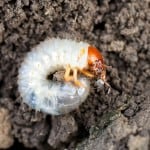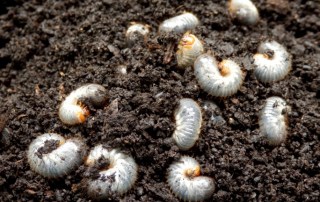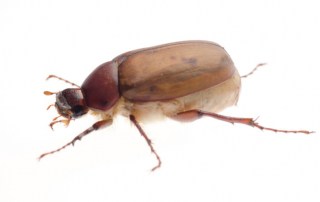Votre panier est actuellement vide !

The White Worm
They are the larvae that cause damage to lawns. Signs of their presence are uneven patches of yellowed or dead grass that can easily fall off and holes in the lawn dug by skunks or raccoons, which are fond of these insects. Damage appears early in the spring and early August.
Latin Name: Melolonthinae
Infestation Signs:
It is the larvae that cause the damage to lawns. Signs of their presence are uneven patches of yellowed or dead grass that can easily fall off and holes in the lawn dug by skunks or raccoons, which are fond of these insects. Damage is seen early in the spring and early August.
Appearance:
Adult:
They are beetles that come out in the evening or at night, they are sometimes called « Barbots » They have dark brown, shiny carapace and they are between 10 and 13 mm long. They have a noisy and characteristic flight.
Larve
– Large creamy white worm with small hairs, brown head,
– Curved body in the shape of a « C ».
– 3 pairs of legs often a little darker.
– Size: 2-4 centimeters long.
Reproduction:
These insects reproduce on a twelve month cycle so they spend the winter underground.
From mid-June to mid-August the adults lay their eggs in the grass, the larvae will hatch two or three weeks later and they will feed on roots to accumulate the energy necessary for their growth and their wintering. Around mid-October, the larvae descend deeper into the soil (25 cm and more) to spend the winter. In the spring, as soon as the snow melts, the larvae wake up and go up just under the grass to eat as many roots as possible once again. When they are gorged, they descend deep into the soil once more to transform into an adult, which will emerge from the earth between mid-May and mid-June to begin the cycle again.
Habits:
The adults are not harmful and seem to prefer among others, the proximity of fruit trees, silver maples and birches. Their nocturnal flights are used for mating and the females once fertilized will immediately lay their eggs.
The larvae, however, are the real problem, they feed on grasses and hardy plants but their favorite food is the Kentucky skate, which is the grass in your lawns. They are terribly voracious and will literally cut the root of grass blades an inch or two below the ground.
Prevention:
The best prevention for grubs is to keep a full and healthy lawn at all times. (put fertilizer). Also, it is recommended to leave the lawn longer (8 cm or 3 inches) during the flight of the adults. (mid-June to mid-August) and not to water too much when the eggs and young larvae are present, that is to say from mid-July to mid-August… We also recommend that you plant clover or other hardy species in place of your grass. This may sound unbelievable but it is what the experts recommend.
Now, WHAT YOU SHOULD KNOW.
If you love your lawn read this:
If you find more than 5 worms per square foot, the damage to your lawn can be considerable.
Grass is a plant that was imported by the English to imitate the gardens of the castles of England and requires enormous quantities of water for its maintenance and very often fertilizers so that it becomes very bushy. Let’s face it: the advice you are given to get rid of grubs naturally is contradictory and not very useful. The longer you leave the grass, the more water it will need to maintain it and if you water less as recommended, it will wither even faster than with grubs. The fertilizer that is suggested to be applied to your lawn may as well go down to the water table and contaminate the water and do more harm than an insecticide.
Another recommendation is to use nematodes, small insects that are parasitic on grubs. This is interesting on the surface, but the treatments are expensive and depending on the harshness of the winters, they largely die off and don’t kill enough grubs to make a difference.
You should also know that Merit©, the trade name for Imidacloprid, is the insecticide that most grub treatment companies use to deal with the problem. It is a member of the neonicotinoid family, a variety of pesticides banned from the European Union because of its terrible effects on bees and other pollinators. This insecticide enters plants and poisons the insects that feed on them.
The liquid insecticides used by lawn care companies are not good solutions because the rain (quite frequent in Quebec) dilutes its effect, displaces it on the lawn and makes it less effective at the precise place where it should act.
OUR POSITION:
ORGANIC DOES NOT WORK, WE MUST ACT INTELLIGENTLY.
Because of our changing seasons, we understand that it is impossible to ask you to cut your lawn longer or shorter and to water your lawn more or less from week to week.
We believe in the benefits of insects and do not want to kill bees and other pollinators.
SO: We propose to get rid of your grubs with a smaller dose of a granular residual insecticide, which will gradually dissolve with rainfall in your lawn and degrade in the environment afterwards. It is proven to be safe for bees and we will only apply it to at risk or affected areas.
Exterior treatments must be done by experts as they must comply with government standards and municipal regulations.

